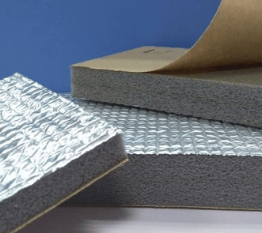
Bubble Insulation
Bubble Insulation: A Comprehensive Guide for Installation and Benefits
If you’re looking for a cost-effective and energy-efficient way to insulate your home or office, then bubble insulation might be the solution you’re looking for. In this comprehensive guide, we’ll take a closer look at bubble insulation, its benefits, the installation process, and everything you need to know before you get started.
Introduction
Insulation is an essential aspect of any construction, as it helps maintain the internal temperature of the building, reducing energy costs. There are different types of insulation materials, and bubble insulation is one of the most popular ones. Bubble insulation consists of two layers of plastic with air bubbles in between. The material is lightweight, easy to install, and provides excellent thermal insulation. Let’s dive deeper into bubble insulation and explore its benefits and installation process.
Bubble insulation, also known as reflective insulation, is a type of insulation that uses reflective material to reflect heat. The insulation material is made up of two layers of polyethylene bubbles with reflective material laminated to both sides. The air trapped in the bubbles provides excellent insulation, while the reflective material reflects the heat. Bubble insulation is available in different sizes and thicknesses to suit different insulation needs.
Bubble insulation in Delhi
Delhi, being a metropolitan city, faces extreme weather conditions throughout the year. The summers are hot and humid, while the winters are cold. Insulation is crucial to maintain the internal temperature of buildings in Delhi. Bubble insulation is an excellent option for insulation in Delhi as it provides both thermal and reflective insulation. The material is easy to install and is cost-effective compared to traditional insulation materials.
Bubble insulation Sheet
Bubble insulation is available in the form of sheets, which makes it easy to install. The sheets come in different sizes and thicknesses, depending on the insulation needs. The sheets are easy to cut, and the material is lightweight, making it easy to handle. Bubble insulation sheets are flexible and can be easily installed on curved surfaces, making it ideal for insulation in attics and crawl spaces.
Bubble Insulation for roof
Roof insulation is crucial in maintaining the internal temperature of a building. Bubble insulation is an excellent option for roof insulation as it provides both thermal and reflective insulation. The reflective material reflects the heat away from the roof, reducing the heat gain in the building. The air trapped in the bubbles provides excellent thermal insulation, reducing the heat loss in the building. Bubble insulation is lightweight, easy to handle, and can be easily installed on different roof types.

Bubble insulation installation
Bubble insulation is easy to install, making it an ideal option for DIY insulation. Here are the steps involved in bubble insulation installation:
Clean the surface: The surface where the insulation needs to be installed should be clean and dry.
Measure the area: Measure the area where insulation needs to be installed and cut the bubble insulation sheets accordingly.
Install the insulation: Install the bubble insulation sheets by stapling or gluing them to the surface.
Seal the edges: Seal the edges of the insulation sheets to prevent air leakage.
Install the reflective material: Install the reflective material over the insulation to provide additional insulation.
Bubble Insulation: An Innovative Solution to Your Insulation Needs
Are you tired of high energy bills during the summer and winter months? Is your home too hot in the summer and too cold in the winter? If you answered yes to either of these questions, then bubble insulation may be the solution you’re looking for.

Bubble insulation is an innovative and effective solution for insulating your home or commercial property. This type of insulation is made up of multiple layers of polyethylene bubbles that are sealed between layers of aluminum foil. The result is a highly efficient insulation material that is lightweight, flexible, and easy to install.
In this article, we will explore the benefits of bubble insulation, how it works, and why it is a cost-effective and environmentally-friendly option for your insulation needs.
Benefits of Bubble Insulation
Cost-Effective
Bubble insulation is a cost-effective alternative to traditional insulation materials such as fiberglass and cellulose. Not only is bubble insulation cheaper to install, but it also requires less maintenance and lasts longer.
Energy-Efficient
Bubble insulation is highly energy-efficient and can significantly reduce your energy bills. The polyethylene bubbles trap air pockets that act as a barrier against heat transfer. This means that in the summer, the heat from outside is prevented from entering your home, and in the winter, the heat from inside is prevented from escaping.
Environmentally-Friendly
Bubble insulation is environmentally friendly and contributes to reducing your carbon footprint. By reducing your energy consumption, you are also reducing the amount of greenhouse gases emitted into the atmosphere.
Easy to Install
Bubble insulation is easy to install and requires no special tools or skills. It comes in rolls that can be easily cut to fit any size space. Additionally, the lightweight and flexible material makes it easy to work with and maneuver into tight spaces.
Versatile
Bubble insulation is versatile and can be used in a variety of applications, including walls, roofs, attics, and crawl spaces. It can also be used in both residential and commercial properties.
How Bubble Insulation Works
Bubble insulation works by creating a barrier against heat transfer. The polyethylene bubbles trap air pockets that act as a barrier against heat transfer. The layers of aluminum foil reflect heat away from your home or property, preventing it from entering or leaving.
When installed properly, bubble insulation can significantly reduce your energy bills by preventing heat loss and gain. This means that your home or property will stay cooler in the summer and warmer in the winter.

Installing Bubble Insulation
Materials Needed
To install bubble insulation, you will need the following materials:
- Bubble insulation rolls
- Scissors or a utility knife
- Tape measure
- Staple gun
- Foil tape
Steps
• Measure the space you want to insulate and cut the bubble insulation to size.
• Staple the insulation to the studs or rafters, making sure to leave no gaps.
• Use foil tape to seal any gaps or seams in the insulation.
• Cover the insulation with drywall or another type of wall covering.
FAQs
Yes, bubble insulation is a cost-effective and energy-efficient alternative to traditional insulation materials such as fiberglass and cellulose.
Yes, bubble insulation is versatile and can be used in both residential and commercial properties.
Yes, bubble insulation is easy to install and requires no special tools or skills.
Bubble insulation works by utilizing the principle of air trapping. The layers of bubbles create a barrier that reduces heat conduction, while the reflective materials reflect radiant heat away from the surface. This combination helps to maintain a stable indoor temperature and reduce energy consumption for heating or cooling.
Bubble insulation offers several benefits, including improved energy efficiency, reduced heat loss or gain, enhanced comfort, and lower utility bills. It is lightweight, easy to install, and can be used in various applications such as roofs, walls, floors, or HVAC systems.
Bubble insulation can be an environmentally friendly option. Some bubble insulation products are made from recycled materials, and they can contribute to reducing energy consumption and carbon emissions by improving a building’s thermal performance.
Yes, bubble insulation is suitable for both hot and cold climates. In hot climates, it helps to reflect radiant heat away from the building, keeping the interior cooler. In cold climates, it acts as a barrier to prevent heat loss and maintain warmth inside the building.
Bubble insulation can have varying degrees of fire resistance depending on the specific product. Some bubble insulation materials are designed to be fire-resistant or have fire-retardant additives to enhance safety. It is important to check the fire resistance ratings and certifications of the specific product you choose.
While bubble insulation primarily focuses on thermal insulation, it can provide some degree of soundproofing by reducing sound transmission through walls or other surfaces. However, if soundproofing is a significant concern, dedicated soundproofing materials may be more effective.
The lifespan of bubble insulation can vary depending on factors such as product quality, installation, and environmental conditions. However, properly installed bubble insulation can typically last for many years without significant degradation.
Yes, bubble insulation is generally easy to install. It comes in rolls or sheets that can be cut to size and attached using adhesive, staples, or other fastening methods. However, for larger or complex installations, it is recommended to consult with a professional to ensure proper installation.
Yes, bubble insulation can be used in existing buildings as well as new construction. It can be retrofitted onto walls, roofs, or other surfaces to improve insulation and energy efficiency without major structural modifications.

0 comments